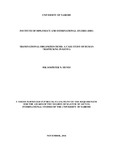| dc.description.abstract | The acts of Human smuggling and trafficking are some of the oldest trades in the world. Despite the many legislations, both local and international that have been put in place to tackle human trafficking, human beings have continued to invent new ways to circumvent them and the numbers of victims involved have been rising sharply, hence the concern of this research. The purpose of this study was to evaluate the global situation of the human trafficking phenomenon narrowing down to explore the situation from the national perspective in Kenya. The study objectives were; to explore the effect of human trafficking on global security; to examine the common forms of human trafficking in Kenya; to identify the major causes of human trafficking in Kenya and to analyse the effectiveness of law enforcement agencies in tackling the human trafficking phenomenon. The study was guided by research questions to help collect and analyse primary data. Rational Choice Theory and Bales’ Theory of Human Trafficking were adopted. The choice of these two theories was informed by their ability to determine push and pull factors that encourage human trafficking activities. Four research hypotheses were formulated to guide the findings of this study. The study hypothesised that a country’s geo-political characteristics determined the nature and levels of organised crime; involuntary servitude and labour trafficking are the most common forms of human trafficking in Kenya; poverty and unemployment levels within the society have a direct relationship with the incidence of human trafficking in Kenya and the lack of appropriate training among law enforcement officers possess a great challenge to the fight against human trafficking in Kenya. The reviewed literature established that human trafficking is a global problem affecting all societies despite the many interventions which have achieved little. The study adopted descriptive survey design to collect primary data. The study targeted Kenya law enforcers drawn from Kenya Police, immigration officials and Directorate of Public Prosecution. The study also targeted key informants which included Interpol, International Organisation for Migration (IOM), United Nations Office of Drugs and Crime (UNODC), Judiciary and victims of human trafficking. Literature was reviewed from global, continental, regional and local perspective in attempt to reveal key study gaps. Purposive sampling was employed to select senior officers of IOM, UNODC and Judiciary. Snowballing method was used to identify human trafficking victims. A total of 128 respondents were sampled for this study. The study used questionnaire and interview schedule as primary data collection instrument to collect quantitative data. Questionnaires were administered to the respondents by the researcher assisted by research assistants while face to face interviews were conducted by the researcher. Quantitative data was analysed using descriptive statistics such as frequencies, means and standard deviations using Statistical Package for Social Sciences computer software version 20. Qualitative data was analysed through data reduction, data discussion and drawing conclusions. Data reduction involved data mining of interview report by transcription that revealed key issues which helped to separate the relevant issues from the irrelevant ones. Data discussion involved the compilation of the reduced data into an organized logical manner. Cross-tabulation will be used to test the relationship between the study variables. The analysed quantitative data was presented in tables and charts while qualitative findings were presented in narratives, verbatim quotations, discussions and making inferences. The study established that there are a number of counter human trafficking interventions in place in Kenya though they have not achieved much. The study recommended as a matter of policy to ensure all law enforcement officers are trained on counter human trafficking. It is hoped that the research findings will be of benefit to the government and stakeholders involved in counter human trafficking effort locally and globally. | en_US |



